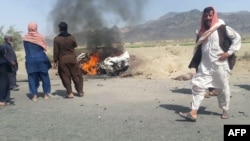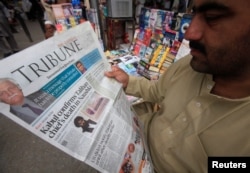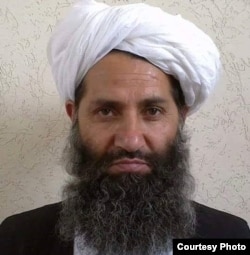Days after a U.S. drone strike in Pakistan, near the Afghan border, killed Taliban leader Mullah Akhtar Mansoor, it remains unclear how the slain leader’s location was discovered.
Mansoor was killed in a remote part of Baluchistan, a province that has been thought off limits for U.S. drones, which operate in the northwestern tribal areas.
However, U.S. officials say the strike does not signal a change in American strategy or an expansion of the CIA’s decade-long drone campaign targeting terrorists inside Pakistan's northwestern tribal areas.
“This was a target of opportunity,” one U.S. official said who declined to be identified when speaking on background. “It does not suggest that we were changing our strategy.”
Karl Eikenberry, who led U.S. forces in Afghanistan and later served as ambassador to Kabul from 2009 to 2011, said knowing Mansoor’s location was a breakthrough the U.S. would not have passed up.
"Acquiring intelligence on these figures has not been an easy task," Eikenberry said. "If we had anything similar earlier, I'm not certain we'd not have chosen to strike."
The strike on Mansoor was the most significant of its kind inside Pakistan since a Navy Seal team killed Osama bin Laden in Abbotabad in 2011 and is the first known drone attack in Baluchistan province, home of the Taliban’s ruling "Quetta Shura." But killing Mansoor outside of Pakistan's tribal areas raises the prospect of deeper turmoil in already-strained U.S.-Pakistani relations.
What did Pakistan know?
How much Pakistani officials knew about Mansoor’s whereabouts and what they shared with the United States remains unknown, but experts say the answer could determine what impact the strike will have on relations between the uneasy allies.
"It’s hard to say what was known or not,” said Jason Campbell, a South Asia analyst at the Rand Corporation. "At this point in time, I’d say that short of other similar attacks occurring in the near future, I don’t see this individual event really moving the needle either way very significantly in the long term."
Pakistan’s foreign office Thursday again called the strike a violation of Pakistan sovereignty and said "all indications" suggested the slain chief, Mullah Mansoor, was preparing to attend peace talks.
That contradicts the U.S., which called Mansoor “an obstacle to peace” who opposed talks and had blocked other Taliban from attending them.
But Alex Vatanka, a senior analyst at the Middle East Institute in Washington, DC, told VOA's Afghan service that despite Islamabad’s objections, Pakistan’s intelligence agency, the Inter-Service Intelligence (ISI), could have “sold” Mansoor to the U.S. Central Intelligence Agency.
“Perhaps Pakistanis thought that Mullah Mansoor was less an asset for them than a liability or perhaps he was moving out of their orbit,” Vantaka said.
Pakistan’s powerful army chief, Gen. Raheel Sharif, who is in charge of the country’s security policy, expressed “serious concerns” over the attack four days later and only after he met with the U.S. envoy to Islamabad, David Hale. Many observers saw that as a low-key response, suggesting that authorities may have been involved in some way.
"The fact that it took three or four days for the Pakistani political elite to really voice any condemnation of the attack and even in a more muted way than in the past, I think certainly opens the possibility that they may have been involved," Rand's Campbell said.
Iranian links?
Mansoor’s Pakistani passport was under an alias, but it had a photo of the Taliban leader as well as stamps indicating he had traveled to Iran.
That set off speculation that Iranian intelligence might have tipped off the CIA, although there is no evidence indicating any such cooperation.
“My professional assumption and speculation: U.S. and Iran’s intelligence collaboration in the targeting and killing of Mullah Mansoor cannot be disregarded… since 2002 till today Iran has tried to change America’s thinking about the roots of terrorism, the modality of war against it and the imposition of security and stability in the Middle East and beyond,” Amrullah Saleh, former Afghan spy chief, wrote on his Facebook page.
Gulbudin Hekmatyar, an Afghan insurgent leader whose name is in the State Department’s global terror list, made a similar allegation concerning the attack on Mansoor.
Impact on peace talks
A group of diplomats from Afghanistan, Pakistan, China and the U.S., known as the Quadrilateral Coordination Group, met in Islamabad this month to push for direct talks between the Taliban and the government. The group condemned a massive Taliban attack in Kabul and “underscored that those who perpetrate such acts of terrorism should be ready to face consequences of their actions.”
The strike may have been the “consequence” the group warned about, said Barnett Rubin, an Afghanistan expert at New York University and a former advisor to the State Department. "I have the impression that [the Pakistanis] want the [peace] process to succeed."
Rubin says there is reason to doubt that Washington will expand the drone campaign. The U.S. has not designated the Taliban as a terrorist organization and targeting another Taliban leader is likely to prove legally problematic. What is more, there is a body of academic research that indicates that "any strategy based on the elimination of leadership doesn’t work," he said.
The U.S. may go after other “targets of opportunity” but it still sees value in its relationship with Pakistan. “If we start shooting drones at people in Quetta and Karachi and start deploying special forces in Quetta and Karachi, then we can say goodbye to our relationship with Pakistan,” Rubin said.










